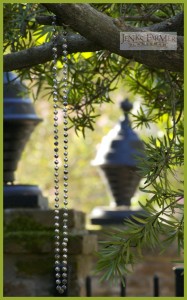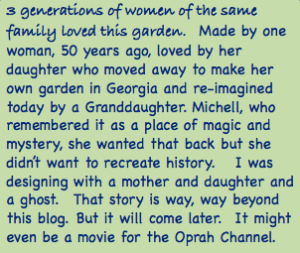Deep Rooted in a Tiny New Orleans Garden
It’s probably true for something you do in your life, some hobby or task: little things, intricate things take more time to plan and are harder to get right than big things.
In planning little gardens, every piece has to fit perfectly. Nature’s complexity is less forgiving and more visible in miniature. A plant that grows too big will smothers something else. A fountain with too much splash causes algea on the walkway. Visual tricks intended to make tight spaces look bigger can go wrong. I want to find balance between making a space feel big and emphasizing the cozy, private feeling. I want to make a small space a jewelry box of a garden.
Proportion is everything. Plants, furniture, fountains, everything has to be in scale–well sometimes intentionally out of scale works too. In small spaces we can more easily see when things go wrong. (Indulge me while I take this topic to the large scale, the earth scale; if you think that we cannot change the climate, can not screw up this earth, then all you need to do is become a gardener. Daily, gardeners see how complex the natural world is. We do one little thing wrong, like spill some gas and you’ll soon see a dead frog or a patch where grass never grows, and who knows what all.) OK, back to the point, in a small garden every detail, not just aesthetic concerns need great attention.
This essay is organized around a few principles that I use in designing— whether for a church, a farm or an office or a small garden. It’s old school, tried and true stuff that is much easier on the earth than is lots of modern horticulture.
I’m not going to delve into each topic; that’s the what for of my book, Deep Rooted Wisdom, which comes out in March. In fact, some of these are chapter topics, but I’ll describe how they work in this little, tropical garden. 
The first step is what I call Finding the Spirit of a Place. That is part site analysis, and part psychology, and part intuition. It’s art and science. Typical site analysis is a step in the right direction but finding the spirit of a place is much more. To start this process, Tom and I spent a long weekend in the garden, with the family. We did all that site analysis and listened to desires, lifestyles, goals and taste of the owner. She plans to care for the garden herself. The spirit of this place is deeply rooted in history but the place has to work for and appeal to a modern woman. To get a feel for the place and neighborhood; it’s one of the famed ‘Seven Sister’s houses’ in this video.
We Don’t Need an Irrigation System. In this courtyard with all the raised beds, brick and sun, when the soil is dry it’s really dry. When there is a downpour, the brick walkways flood. The beds don’t flood but they saturate. The dirt is fine textured, black clay and highly organic. So it will hold water well. Since New Orleans gets 65 inches of rain a year, plants get watered. We needed plants that tolerate alternating flooding and drought.
So its a no brainer that we’ll pick plants genetically suited to that. But there’s more. We’ll pick plants that are properly grown, by a nursery using proper soil/dirt/media. Think about this: cypress trees may live in the swamp, in 3 feet deep water. But a cypress tree grown in a nursery, in fast draining ‘soil’ will drown if you try to plant it in that same swamp. Many nurseries today use very light mixes, experimental mixes in fact, with little understanding of how that affects the plant’s transition into garden dirt. The point is, to get plants established it helps to buy them from a real nursery.
Even so, I do some things to prepare plants for the move from nursery to garden. For two weeks before planting, I inoculated with bacterial and fungal spores to build a population of helpful life in their roots. Just before planting, all containers were soaked in a tub with a weak seaweed solution. At the last botanical garden that I established, we had a rule— no plant went into the ground without being sunk in a container of water until totally saturated.
We Plan Not to Add Fertilizer. The dirt was amended with compost a few months before planting. The plants are well prepared with helpful microbes living in their roots. These tiny creatures, yes they are living magnificent creatures, help plants reach nutrients in the dirt, in chunks of wood or other organic mater in the dirt.
To succeed here, the process is the same as above; pick the right plants. It’s my standard practice to incorporate plants that have the unique ability to pull nitrogen out of the air and pass it on via roots and microbes to other plants. Here, we had the benefit of a huge Podocarpus, which can fix nitrogen for all the groundcover plants in one area. Normally, I include inoculated legumes. In this garden though, I tried something that is a bit untested. Ardisia is a ground cover in a family of other plants that fix nitrogen about there’s been inconclusive research about it. (I used Ardisia ‘Angyro Pixie.’ for it’s delicate leaves—well proportioned for small spaces.)
We also used plants that just don’t need much fertility. Like the thread leafed Asian Jessamine called ‘Theta’ and pomegranate trees of course, we’re also setting realistic expectations of growth— no desire to make plants explode out of bounds from over fertilization.
We Stacked Functions. We picked plants that satisfy multiple needs. Being pretty isn’t quite enough. Michelle wanted plants to add to meals. Everything in the courtyard, but the boxwood, has a food use. The

pomegranate does three things: it adds privacy, it makes fruit and it makes a great cut greenery for holidays. Rectangular panels, mimicking the shape of the courtyard, the bed and even the brick hold an important
ayurveda herb, Indian Sarsasparillo (Hemidesmus indicus). The Saspariillo also does three things: its medicinal, its pretty on the wall and it will reduce the heat from the brick wall that makes the courtyard warm up in the
summer. Its a layer of insulation.
Michell wanted more. We converted a utility area into a vegetable garden. Here too, proportion and layout were key. The rectangular space seemed to called for square beds. But big squares wasted space and were hard to walk around. So a creative twist to make them into diamonds solved the problem (see plan) and made a more inviting view from afar. That layout allows for a tiny table and chair too. Those became vegetable beds with an espalier citrus and a lemon grass planted in the ground.
We Minimize Waste. The excessive use of plastic pots kills me (here’s a whole essay on that topic) but we planned this garden from afar, so plastic pots made plant transport easy. To minimize plastic, we used Cyperus diffuses grown in pots made from compressed cow manure. And instead of buying veggies in plastic six packs we bought seeds for the veggie garden and nasturtium seed to add a little quick color.
To minimize consumer waste, we worked with local craftsmen who built all the trellises, veggie boxes and containers. No bad smelting, or concern over endangered tropical woods. We even used local bamboo to build our protective structures. Maybe in the scheme of things this is tiny. But think about those little bamboo sticks they sell in big box stores — they’re grown in China, died green, packed in plastic bags, cargo-shipped across the ocean and carried home in your car. It’s better for us all just to cut some from the neighbors.
And finally, it all comes back to picking the right plants. The exactly-fit-for-the spot-plants. I realize more and more that designers hold responsibility for so much waste, so much fume and noise pollution. How? By installing and specifying the wrong plants in the wrong spots. Here’s a perfect example that’s common as dirt and just plain bad plant choice: Imagine a landscape in your neighborhood where the purple loropetalum have to be sheered monthly to keep them from covering up the windows. The maintenance crew uses a power trimmer, a power blower to clean up and leaves it all on the street to be carried to the landfill. We don’t do it that way.
It’s a microcosm, this little New Orleans garden. Your garden is too. Gardening is a metaphor for how we view ourselves in this unimaginably complex earth. In the big scheme of things, getting the little details right, matters in ways we can’t imagine.[Not a valid template] Thanks to a great team: John, Shane, Tom, Jose, Jennifer, Betsy, Jamie, Gloria, Ted, Jacob and Bonnie & Michell for sharing their history & future of their garden.

Great essay! Really makes me anxious to see the book when it’s finally released next Spring.